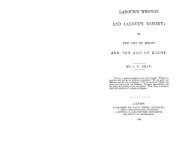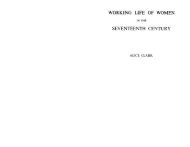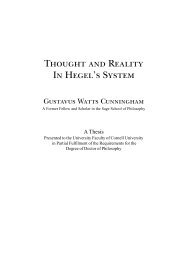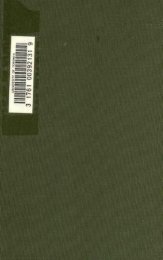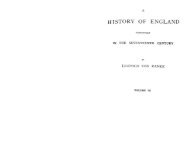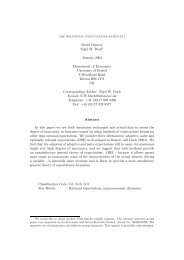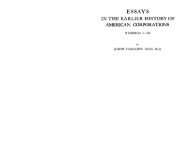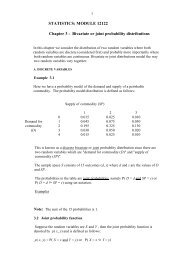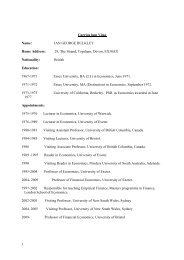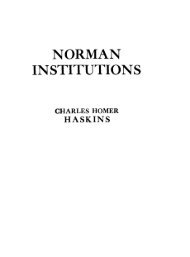The Constitutional History of England
The Constitutional History of England
The Constitutional History of England
You also want an ePaper? Increase the reach of your titles
YUMPU automatically turns print PDFs into web optimized ePapers that Google loves.
10 <strong>Constitutional</strong> <strong>History</strong> PERIODwhich an orderly written record is kept. <strong>The</strong> sheriffs accountsfor 1132 are still extant on what is called the Pipe Roll <strong>of</strong>3 I Hen. I ; this is one <strong>of</strong> our most valuable sources <strong>of</strong> information.It has been casually preserved; it is not until thebeginning <strong>of</strong> Henry 11's reign that we get a regular series <strong>of</strong>such records. To illustrate the Norman reigns we have alsoa few un<strong>of</strong>ficial records <strong>of</strong> litigation. <strong>The</strong>se have been printedby Mr Bigelow in his Placita Anglo-Normannica. <strong>The</strong>genuine laws <strong>of</strong> William I and the Charter <strong>of</strong> Henry I willbe found in Stubbs' Select Charters. <strong>The</strong> so-called LegesEdwardi Co?zfes.soris, WilleZnzi Conqzbestoris, and Henrici Prinziare among the Ancient Laws published by the RecordCommissioners1.iii. Henry 11 (I I 54-89), Richard (I 189-gg), John (I 199-1216).<strong>The</strong> reign <strong>of</strong> Henry I1 is <strong>of</strong> great importance in legalhistory; he was a great legislator and a great administrator.Some <strong>of</strong> his laws and ordinances we have, they have beencasually preserved by chroniclers ; others we have lost. <strong>The</strong>time had not yet con~e when all laws would be carefully and<strong>of</strong>ficially recorded. At his coronation or soon afterwards heissued a charter, confirming in general terms the libertiesgranted by his grandfather, Henry I. <strong>The</strong> next monumentthat we have <strong>of</strong> his legislation consists <strong>of</strong> the Constitutions <strong>of</strong>Clarendon issued in I 164. Henry's quarrel with Becket wasthe occasion <strong>of</strong> them. <strong>The</strong>y deal with the border land betweenthe temporal and the ecclesiastical jurisdictions, defining theprovince <strong>of</strong> the spiritual courts. During the anarchy <strong>of</strong>Stephen's reign the civil, as contrasted with the ecclesiastical,organization <strong>of</strong> society had been well-nigh dissolved-thechurch had gained in power as the state became feeble.Henry endeavoured to restore what he held to be the ancientboundary, to maintain the old barriers against the pretensions<strong>of</strong> the clergy. <strong>The</strong>se Constitutions are the result. To some<strong>The</strong> Leps Edwnrdi Confessoris and the Legees Henrici Prinri may now beread in- Liehermann's Gesetze der Angelsachsen. For a full and valuable commentaryon the latter document see Stubbs, Lectures on Early English <strong>History</strong>,1~3-65. For the Leges Willelmi see Stubbs, Select Charters, p. 84.I Growth <strong>of</strong> the Canon Law I Iextent Henry failed : the murder <strong>of</strong> the Archbishop shockedthe world, and shocked him, and he was obliged to surrenderseveral <strong>of</strong> the points for which he had contended. Neverthelessin the main he was successful ; by the action <strong>of</strong> theroyal court which now becomes steady and vigorous a line wasdrawn between the temporal and the spiritual spheres, thoughit was not exactly the line which Henry tried to define, andthough for a century and more after his death there was stilla debateable border land. <strong>The</strong> Canon law was just takingshape, a law for ecclesiastical matters common to all Europe.One great stage in its development is marked by the Decretr~vzGratiani, the work <strong>of</strong> a Bolognese monk, composed, it isbelieved, between I 139 and I 142, i.e. in our King Stephen'sreign. <strong>The</strong> decrees <strong>of</strong> ecclesiastical councils, ancient andmodern, genuine and spurious, were being elaborated into agreat system <strong>of</strong> jurisprudence. <strong>The</strong> classical Roman law, whichfor some time past had become the subject <strong>of</strong> serious study,was a model for this new system. We have to rememberthat throughout the subsequent ages Canon law administeredby ecclesiastical courts regulated for all Englishmen some <strong>of</strong>the most important affairs <strong>of</strong> life. It did not merely definethe discipline <strong>of</strong> the clergy-all matters relating to marriagesand to testaments fell to its share. A great deal <strong>of</strong> theordinary private law even <strong>of</strong> our own day can only be understoodif we remember this. <strong>The</strong> fundamental distinction thatwe draw between real and personal property, to take oneexample, is the abiding outcome <strong>of</strong> the division <strong>of</strong> the field <strong>of</strong>law into two departments, the secular and the spiritual. Whydo we still couple ' probate ' with ' divorce ' ? Merely becauseboth matrimonial and testamentary causes belonged to thechurch courts.We have just mentioned the revived study <strong>of</strong> Roman law.In Southern Europe Roman law had never perished: ithad survived the dark ages in a barbarized and vulgarizedform. <strong>The</strong>n in the eleventh century men began to turnonce more to the classical texts. <strong>The</strong> new study spreadrapidly. In 1143 Archbishop <strong>The</strong>obald brought hither inhis train one Vacarius, a Lombard lawyer. He lectured in<strong>England</strong> on Roman law; it seems that Stephen silenced



